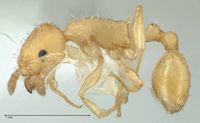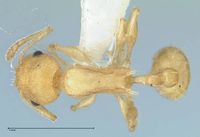Temnothorax indra
| Temnothorax indra | |
|---|---|

| |
| Scientific classification | |
| Kingdom: | Animalia |
| Phylum: | Arthropoda |
| Class: | Insecta |
| Order: | Hymenoptera |
| Family: | Formicidae |
| Subfamily: | Myrmicinae |
| Tribe: | Crematogastrini |
| Genus: | Temnothorax |
| Species: | T. indra |
| Binomial name | |
| Temnothorax indra (Terayama & Onoyama, 1999) | |
| Common Name | |
|---|---|
| Kiiro-muneboso-ari | |
| Language: | Japanese |
This species nests in dead twigs on standing trees (Japanese Ant Image Database).
Identification
T. indra is similar to Temnothorax basara, but distinguished by the mesosomal dorsum with longitudinal rugulae.
Keys including this Species
Distribution
Distribution based on Regional Taxon Lists
Palaearctic Region: Japan (type locality).
Distribution based on AntMaps
Distribution based on AntWeb specimens
Check data from AntWeb
Countries Occupied
| Number of countries occupied by this species based on AntWiki Regional Taxon Lists. In general, fewer countries occupied indicates a narrower range, while more countries indicates a more widespread species. |

|
Estimated Abundance
| Relative abundance based on number of AntMaps records per species (this species within the purple bar). Fewer records (to the left) indicates a less abundant/encountered species while more records (to the right) indicates more abundant/encountered species. |

|
Biology
Castes
Nomenclature
The following information is derived from Barry Bolton's Online Catalogue of the Ants of the World.
- indra. Leptothorax indra Terayama & Onoyama, 1999: 85, fig. 18 (w.q.) JAPAN. Combination in Temnothorax: Bolton, 2003: 271.
Unless otherwise noted the text for the remainder of this section is reported from the publication that includes the original description.
Description
Worker
Holotype. HL 0.68 mm; HW 0.54 mm; CI 79; SL 0.53mm; SI 98; WL 0.78 mm; PW 0.40 mm; PtW 0.16 mm; PtH 0.20 mm; TL 2.5 mm.
Head 1.3 times as long as wide, with feebly convex posterior margin in full-face view; sides behind eyes slightly converging posteriorly. Mandibles longitudinally rugulose. Anterior margin of clypeus moderately convex. Antennae with 12 segments; scapes long, slightly exceeding posterior margin of head in full-face view. Eyes 0.16 mm in maximum diameter.
Promesonotal dorsum feebly convex in profile. Metanotal groove shallowly incised dorsally. Propodeal dorsum flat with a small convexity near the anterior end; propodeal spines s lender and long, about 4 times as long as their basal width, and a little downcurved near the tips.
Petiole long, with long peduncle and reverse U-shaped node. Subpetiolar process a very small tooth, triangular. Postpetiole slightly longer than high; node in profile with convex anterior and straight posterior slopes; in dorsal view 1.5 times as wide as long, with convex sides and nearly straight anterior margin.
Head dorsum longitudinally rugulose, the spaces between densely punctulate. Mesosomal dorsum and pronotal sides rugose. Mesonotal and propodeal sides and petiole densely punctulate. Postpetiole more weakly punctulate. Gaster smooth and shining.
Head dorsum with stout erect hairs; mesosomal dorsum with about 14 erect hairs; the longest hair on mesosoma 0.10 mm; petiole with 2 pairs, and postpetiole with 5 pairs of erect hairs; gaster moderately abundant stout erect hairs.
Head, body, and appendages yellow.
Type Material
Holotype. Worker, Mt. Yonaha-dake, Okinawa I., Okinawa Pref., 16.V.1982, H. Takamine leg. Paratypes. 9 workers, same data as holotype; 7 workers, 1 female, same locality, 21.VIII.1991, M. Terayama leg.
Determination Clarifications
T. indra corresponds to Leptothorax sp. 7 of Terayama et al. (1992).
References
- Bolton, B. 2003. Synopsis and Classification of Formicidae. Mem. Am. Entomol. Inst. 71: 370pp (page 271, Combination in Temnothorax)
- Katayama, M., Tsuji, K. 2010. Habitat differences and occurrence of native and exotic ants on Okinawa Island. Entomological Science 13, 425–429 (doi:10.1111/j.1479-8298.2010.00400.x).
- Terayama, M. and K. Onoyama. 1999. The ant genus Leptothorax Mayr (Hymenoptera: Formicidae) in Japan. Memoirs of the Myrmecological Society of Japan. 1:71-97.
References based on Global Ant Biodiversity Informatics
- Shimono A., and S. Yamane. 2003. Ant species diversity on Okinoerabu-jima, the Ryukyus, southern Japan. For the Establishment of Remote Islands Study (Kagoshima Univ.) 3: 11-29.
- Terayama M.; Onoyama, K. 1999. The ant genus Leptothorax Mayr (Hymenoptera: Formicidae) in Japan. Memoirs of the Myrmecological Society of Japan 1:71-97.
- Yamane S. 2016. How many species of Ants in Amami Islands? (in Japanese). Part 2, chapter 1 in How many species of Ants in Amami Islands? Pp. 92-132.
- Yamane S., S. Ikudome, and M. Terayama. 1999. Identification guide to the Aculeata of the Nansei Islands, Japan. Sapporo: Hokkaido University Press, xii + 831 pp. pp, 138-317.
- Yamane S.; Ikudome, S.; Terayama, M. 1999. Identification guide to the Aculeata of the Nansei Islands, Japan. Sapporo: Hokkaido University Press, xii + 831 pp. pp138-317.

